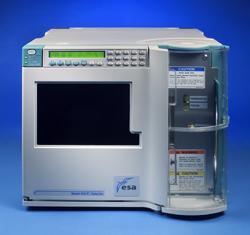|
Instrument Database:
ESA Inc. - Model 530 High Sensitivity Fluorescence Detector
| |
|

|
| |
|
| |
|
| Year of introduction |
|
| Status |
historical ( out of sale ) |
| Company |
ESA Inc.
|
| Categories |
Chromatography: LC-Detector: Fluorescence
|
- Programmable Emission & Excitation Wavelengths
- Easy-to-use Control Pad
- Automatic lamp startup/shutdown
- Pre-aligned lamps for easy changeover
- Internal self-diagnostics
- Optimized for use with ESA Coulometric electrochemical detection
The unique three-dimensional optical alignment technologies used in the Model 530 significantly reduces loss of light and provides high sensitivity in fluorescence measurement. Compounds that exhibit strong fluorescence are likely to be detected at concentrations nearly two orders of magnitude lower than UV-Vis absorbance. With this "bright" optical system, the Model 530 detector can provide a signal-to-noise ratio of over 600.
The detector can be operated as stand-alone module via the supplied control pad or through integration into the EZChrom™ Elite for ESA Chromatography Data System. Automatic wavelength calibration and documentation within EZChrom™ Elite for ESA software make it easy to comply with government regulations. And, control of external device functions is provided through programmable contacts.
The beam from the Xenon lamp converges on the excitation monochromator and disperses over a concave diffraction grating structured for minimal light loss. The programmed wavelength then passes through the variable exit slit. The sample in the flow cell is excited and the resulting fluorescence (emitted radiation) enters an emission monochromator. The selected emission wavelength strikes a measuring photomultiplier where the intensity of the excitation beam is measured as a function of time.
You can select from a wide range of wavelengths and functions to collect and save excitation/emission spectra. Time programming for excitation/emission wavelengths is supported. The slit width is adjustable between 15 nm and 30 nm, providing greater sensitivity. Detection wavelengths may be time-programmable for optimum detection sensitivity of each analyte.
Automatic lamp shutdown during inactive periods increases overall lamp life. Lamp usage is easily monitored through the front panel keypad and display. Simple programming is provided for wavelength scanning and range changes during an analytical run.
Long-life replacement lamps and accessories are also available.
|
| Specifications |
|
Optics Ratio-beam photometric detector using transmission light
Light source Xenon lamp (150W)
Wavelength Calibration Automated: via Hg lamp (built-in)
Excitation Range: 200 to 850 nm Zero Order
Spectral Bandwidth: 15 nm
Emission Range: 250 to 900 nm Zero Order (operation above 731 nm requires PMT exchange)
Spectral Bandwidth: 15 nm, 30 nm variable
Sensitivity S/N S/N: > 600 for Raman spectrum of water
(EX: 350 nm; time constant: 2 sec; bandwidth: 15 nm; baseline method)
Wavelength Accuracy ± 3 nm
Wavelength Reproducibility ± 0.5 nm
Programs 9 programmable (max. 100 steps)
Available functions Wavelength (EX and EM), time, autozero, and hold
Operating Functions By keypad or external communication (e-Line)
External I/O Contact Terminals Time program start, error input/output, busy output, auto zero input, marker input (Option), lamp off
Display Function 40 characters x 2 lines on backlighted LCD
GLP functions Auto calibration using Hg lamp
Lamp energy check
Log for usage
Replacement date
Spectrum memory Memorized contents, Absorbance spectra and energy spectra (battery protected)
Memorized Spectra Absorbance/energy spectra: 3
Background spectrum: 1
Flow Cell 12µl (illuminated capacity) Max Press.: 1.0 MPa
Signal Output Analog: 0-1 V full scale
Safety Built-in leak sensor, error handling
Power Requirements 100- 240 VAC 50/60 Hz (450 VA)
Dimensions 340 (W) x 400 (D) x 300 (H) mm
Weight Approx. 50 lbs (23 kg)
|
|